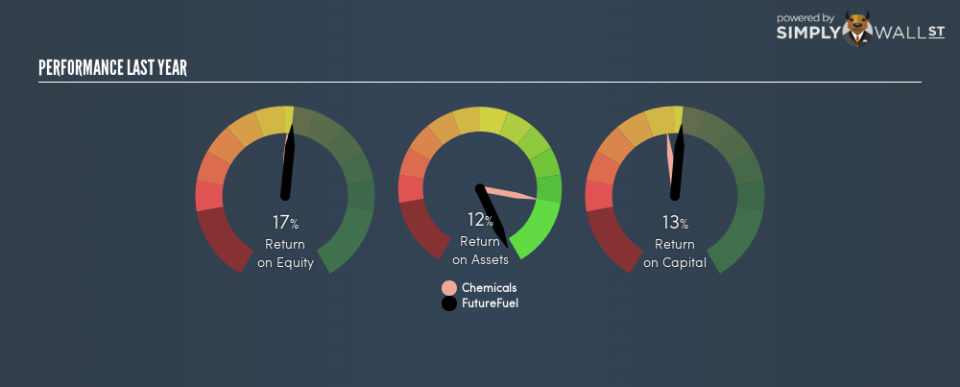Here’s What FutureFuel Corp.’s (NYSE:FF) Return On Capital Can Tell Us

Today we are going to look at FutureFuel Corp. (NYSE:FF) to see whether it might be an attractive investment prospect. To be precise, we’ll consider its Return On Capital Employed (ROCE), as that will inform our view of the quality of the business.
First of all, we’ll work out how to calculate ROCE. Second, we’ll look at its ROCE compared to similar companies. And finally, we’ll look at how its current liabilities are impacting its ROCE.
What is Return On Capital Employed (ROCE)?
ROCE is a metric for evaluating how much pre-tax income (in percentage terms) a company earns on the capital invested in its business. Generally speaking a higher ROCE is better. Overall, it is a valuable metric that has its flaws. Renowned investment researcher Michael Mauboussin has suggested that a high ROCE can indicate that ‘one dollar invested in the company generates value of more than one dollar’.
How Do You Calculate Return On Capital Employed?
Analysts use this formula to calculate return on capital employed:
Return on Capital Employed = Earnings Before Interest and Tax (EBIT) ÷ (Total Assets – Current Liabilities)
Or for FutureFuel:
0.13 = US$9.9m ÷ (US$483m – US$52m) (Based on the trailing twelve months to September 2018.)
Therefore, FutureFuel has an ROCE of 13%.
Check out our latest analysis for FutureFuel
Is FutureFuel’s ROCE Good?
ROCE is commonly used for comparing the performance of similar businesses. Using our data, FutureFuel’s ROCE appears to be around the 12% average of the Chemicals industry. Independently of how FutureFuel compares to its industry, its ROCE in absolute terms appears decent, and the company may be worthy of closer investigation.
When considering this metric, keep in mind that it is backwards looking, and not necessarily predictive. Companies in cyclical industries can be difficult to understand using ROCE, as returns typically look high during boom times, and low during busts. This is because ROCE only looks at one year, instead of considering returns across a whole cycle. How cyclical is FutureFuel? You can see for yourself by looking at this free graph of past earnings, revenue and cash flow.
How FutureFuel’s Current Liabilities Impact Its ROCE
Current liabilities include invoices, such as supplier payments, short-term debt, or a tax bill, that need to be paid within 12 months. The ROCE equation subtracts current liabilities from capital employed, so a company with a lot of current liabilities appears to have less capital employed, and a higher ROCE than otherwise. To check the impact of this, we calculate if a company has high current liabilities relative to its total assets.
FutureFuel has total liabilities of US$52m and total assets of US$483m. Therefore its current liabilities are equivalent to approximately 11% of its total assets. Current liabilities are minimal, limiting the impact on ROCE.
Our Take On FutureFuel’s ROCE
With that in mind, FutureFuel’s ROCE appears pretty good. But note: FutureFuel may not be the best stock to buy. So take a peek at this free list of interesting companies with strong recent earnings growth (and a P/E ratio below 20).
I will like FutureFuel better if I see some big insider buys. While we wait, check out this free list of growing companies with considerable, recent, insider buying.
To help readers see past the short term volatility of the financial market, we aim to bring you a long-term focused research analysis purely driven by fundamental data. Note that our analysis does not factor in the latest price-sensitive company announcements.
The author is an independent contributor and at the time of publication had no position in the stocks mentioned. For errors that warrant correction please contact the editor at editorial-team@simplywallst.com.

 Yahoo Finance
Yahoo Finance 
